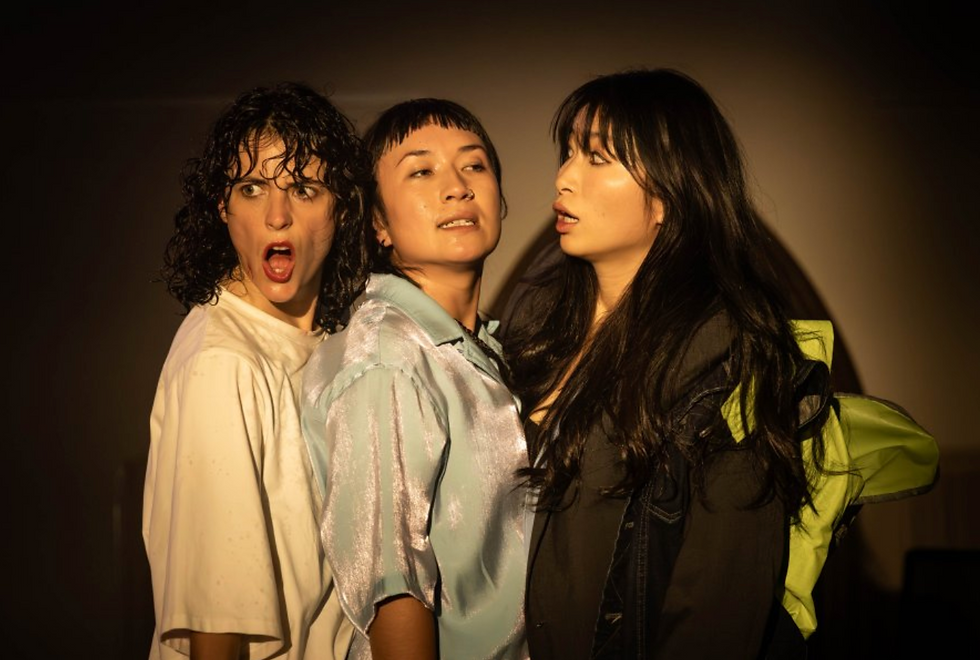Review: The Black Woman of Gippsland, MTC at Southbank Theatre
- Theatre Travels

- May 10
- 4 min read
Reviewed by Susanne Dahn
Andrea James and her highly talented ensemble of performers and creatives has thrillingly manifested on the stage the profound human truth that stories matter, monuments and dedications matter, names matter and what gets remembered matters.
The biggest story to come out of Gippsland in the 1840s was the search (and, as it turned out, destroy) missions for a lost white women said to have been shipwrecked at Ninety Mile Beach and held captive near today’s Port Albert by members of the Brataualung clan of the Gunaikurnai nation.
Angus McMillan, a Scottish explorer who later squatted on land in Gippsland as a pastoralist, started the story with a letter to the Sydney press reporting that he had come across a deserted Gunaikurnai camp strewn with female items and the remains of a dead white child.
The story of a captive white woman led to search parties - emanating in part from the exclusive Melbourne Club - consisting of Angus McMillan’s men and Native Police pursuing the Gunaikurnai people to rescue the damsel in distress. Rewards were offered. Handkerchiefs printed in English and Gaelic to guide the woman to safety were nailed to trees.
The search parties captured Gunnakurnai elder, warrior, medicine and lawman Bungelene and he and members of his family were held as ransom for the missing white woman resulting in some of the most horrific first Aboriginal deaths in police custody at the Dandenong police paddocks.
It is unclear whether a captive woman was ever found. A ship’s figurehead however, was recovered, leading to speculation that it may have been mistaken for the white women.
The White Woman of Gippsland story that a European woman was “captive of ruthless savages” became the justification for the continued harassment and killings of Aboriginal people in Gippsland.
Massacres led by McMillan occurred at Nuntin, Boney Point, Butchers Creek, Maffra and at other locations throughout Gippsland. The massacre at Warrigal Creek that killed up to 180 is recognised as one of the worst in Australian colonising history.
Today the Gunaikurnai live in a region still dotted with monuments that remind people of the colonial violence enacted by men. One plaque sickenenly describes McMillan as an explorer who achieved “territorial ascendancy over Gippsland Aborigines”.
The Melbourne Theatre Company (MTC) commissioned Yorta Yorta/Gunaikurnai playwright and director Andrea James (descended from the Thorpe and Pepper clans) in 2020 to develop this work as part of the MTC’s Next Stage Writer’s Program and the Yirramboi Festival.
Andrea James has been supported in the development by a strong and varied creative team including cousin Brent Watkins as choreographer, Uncle Wayne Thorpe as Gunnakurnai Cultural Consultant and eminent theatre maker Patricia Cornelius.
The result is a fast paced, riveting and superbly stagecrafted production deftly directed by Andrea James to bring out many rich strands of humour, frustration and grief in a play that explores the burdens and blessings of place and kinship ties.
Blakademic Jacinta (played with great vigour and nuance by Chenoa Deemal) is pursuing a PhD that explores the White Woman story. Her own much loved mother has died, so she lives fractiously in the backyard caravan of steadfast Auntie Rochelle (played with deep feeling and strength by Ursula Yovich) and young somewhat wayward cousin Kyle (played with energy and charm by Zach Blampied).
Jacinta’s time and options to submit her PhD proposal are nearly up, but the way she wishes to explore the story is at odds with academic protocols. Oral histories require ethics clearance even when they’re your family. Or a lake. Or a tree. This story fights for the righteously powerful to control the narrative. And I reckon it wins.
Another white man A.W. Howitt, anthropologist and local magistrate, left a different legacy to McMillan as he observed and documented the last young men’s initiation ceremony of the Gunaikurnai back in 1884 at a site located on the edge of the small fishing village of Seacombe on Lake Wellington.
Howitt‘s recordings of Gunnakurnai language have been turned into the sonic landscape of this work by composer and sound designer James Henry. The vocal and instrumental soundtrack to this play is stunningly good.
Stunningly good is also the movement and dance with Brent Watkins’ work as the performer harmonising with the unfolding story in a most haunting and evocative way. The expression in Watkins legs and his heavenly winged arms as he danced is simply a joy to behold.
Brilliant lighting design, clever set design and inspired costuming and artefacts complete the very accomplished stagecraft on show here. This work will draw much acclaim and deserves extended life and to be seen by many.
Writer Andrea James deeply understands the importance of story, of words and of naming.
It is good to know that in 2019 that the Australian Electoral Commission approved changing the name of the South Gippsland federal seat of McMillan to Monash in response to community calls for change.
It is less good that in 2020 the Wellington Shire Council is still committed to keeping the historical cairns honouring Angus McMillan on council-owned land in Sale and Stratford despite the 240 submissions. Another 18 monuments are dotted across Gippsland, including at Heyfield, Yarram, Omeo and Lucknow.
This story is dedicated to Leanne Lyn Pepper. There are many stories like hers and they all matter. Ideally every Victorian should know the story so we might all understand and remember each other’s stories and find in them what is true. It matters a lot. We reckon.





